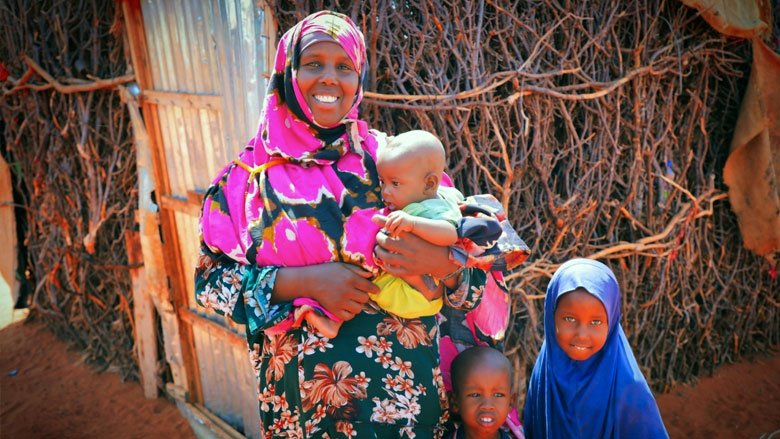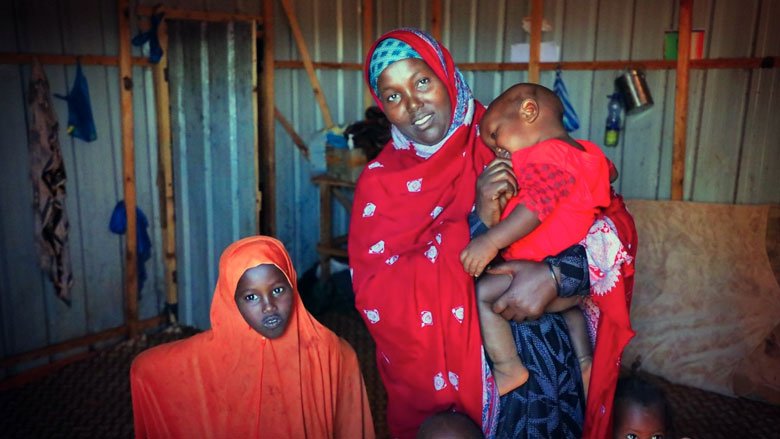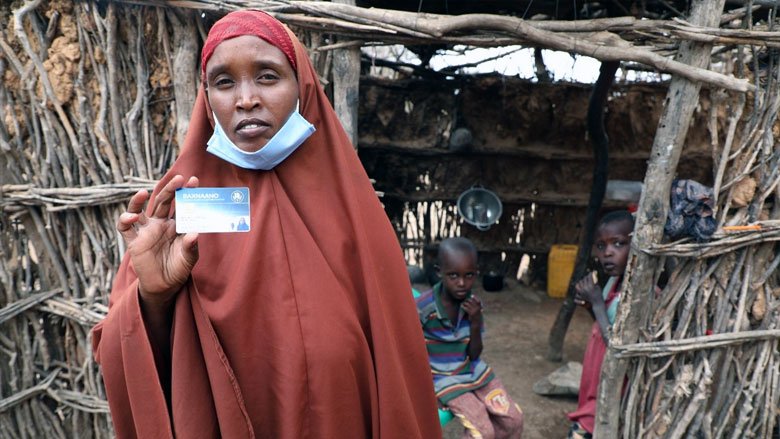Challenge
Fragility and increasing exposure and vulnerability to covariate shocks have continued to disrupt livelihoods and exacerbate poverty and food insecurity in Somalia. Since 2016, the country has grappled with alternating sequences of severe droughts and large-scale floods, which combined with the outbreak in 2020 of the worst desert locust infestation in 25 years. Resource scarcity, driven by climate shocks, fuels displacement, as well as localized conflict and violence. These challenges compound Somalia’s already difficult transition out of prolonged war by protracting insecurity and instability. The total number of internally displaced people (IDPs) was nearly 2.97 million in 2021, up by around 1.85 million people since 2016 as a result of natural disasters and conflict. Income and livelihood losses amid these shocks and the COVID-19 pandemic have aggravated already widespread poverty and deprivation, with an estimated 71% of the population struggling to survive below the poverty line. This represents an increase of about 300,000 people since 2017. Pervasive and deep poverty prevails in IDPs settlements, rural areas, and among children. Children under 14 represent nearly 50% of the population but make up one half of all Somalis living in poverty. About 6 million people (38% of the population) faced acute food insecurity (IPC Phase 3 and above) between April and June 2022 as a result of an exceptionally severe drought. The compound effects on climate of the soaring food prices inflation driven by the war in Ukraine have raised the specter of famine, with 7.1 million projected to face acute food insecurity between June and September 2022.
Approach
Baxnaano takes a two-pronged approach, focused on addressing urgent needs in the short-term while investing in national systems and capacities through long-term programming. Launched through the Shock Responsive Safety Net for Human Capital Project (SNHCP), Baxnaano (“uplifting” in Somali) was originally planned to respond to the 2019 drought, using the rapid drought response as an opportunity to gradually develop longer-term support for chronic poverty and food insecurity. The compounding shocks facing the country at the time of project preparation, and with the FGS having limited capacity and no national social safety net (SSN) system to respond, required Baxnaano to immediately step up as the primary delivery platform to support wider and longer-term objectives of human capital accumulation and recovery, while contributing to state-building by promoting government ownership and a renewed social contract.
To attain these objectives, Baxnaano incorporated: (i) nutrition linked UCTs of $20 a month per beneficiary household for a three-year cycle, delivered through mobile money; (ii) support to developing key SSN delivery systems; (iii) institutional capacity building.
Given Baxnaano’s early encouraging results, the World Bank financed its rapid scale-up (Baxnaano-Shock) by approving the Shock Responsive Safety Net for Locust Response Project (SNLRP). Baxnaano-Shock protected the food security and livelihoods of locust-affected households by providing ECTs, including a temporary $40 top-up a month to existing Baxnaano-Regular beneficiaries and a monthly flat benefit of $60 to non-Baxnaano beneficiary households for up to 6 months.
Results
Baxnaano-Regular and Baxnaano-Shock provided a single platform to deliver regular, predictable, and scalable cash transfers in Somalia. The program has played a crucial role in protecting food security and livelihoods, promoting human capital, and strengthening the resilience of poor households to climate and other shocks. During the first two years of implementation:
- 200,000 households (over 1 million individuals) benefitted from predictable nutrition-linked UCTs from Baxnaano-Regular. Women accounted for one hundred percent of Baxnaano-Regular UCTs direct recipients, nearly 40% of whom accessed SIM cards for the first time, marking a major step in promoting the financial inclusion of poor women in Somalia.
- Nearly 100,000 households (approx. 600,000 individuals) received livelihood protection through monthly ECTs in response to the locust crisis. Seventy-two percent of Baxnaano-Shock direct recipients were women.
Good progress has also been made in developing key delivery systems under the Ministry of Labor and Social Affairs (MoLSA) and in strengthening institutional arrangements. Particular emphasis has been placed on establishing: (i) a targeting methodology based on evidence-based evaluation and lessons learned from implementation to date, to identify more accurately the poorest households and enhance the program’s effectiveness; (ii) a Unified Social Registry (USR), including the development of a Common Registration Form (CRF), to ensure harmonized household information for all programs, facilitate program coordination and efficiency, and support the FGS’ efforts to effectively serve its citizens; and (iii) a Government-led Social Protection Working Group, chaired by MoLSA to ensure alignment and coordination between the FGS’ social protection agenda and donor-supported development and humanitarian interventions.
Bank Group Contribution
The SNHCP was launched in September 2019 as a $65 million operation financed through an International Development Assistance (IDA) Pre-Arrears Clearance Grant. In 2020, the SNLRP was approved with a $40 million IDA grant to scale up Baxnaano in response to the locust crisis. In September 2021, the World Bank launched two companion $185 million additional financing operations to support the continuation of the SNHCP for two additional years ($110 million) and the expansion of the SNLRP ($75 million). The financing for the SNLRP was part of the regional Emergency Locust Response Program (ELRP) using the Multiphase Programmatic Approach (MPA) approved in 2020.
Partners
Baxnaano has benefitted from a broad partnership platform, and effective collaboration with partners has provided a framework for successful implementation and growing program alignment. The World Food Program (WFP) and the United Nations Children’s Fund (UNICEF) are providing direct support to MoLSA for overall program implementation.
Donors and development partners, including, but not limited to, the Foreign, Commonwealth and Development Office (FCDO), the European Union (EU), the European Civil Protection and Humanitarian Aid Operations (ECHO), the United States Agency for International Development (USAID), UN agencies such as WFP, the Food and Agriculture Organization (FAO), and the Office for the Coordination of Humanitarian Affairs (OCHA), as well as NGOs, have joint efforts to ensure collaboration on data sharing and to coordinate on targeting.
Sustained dialogue has promoted alignment and coordination with the donors of humanitarian agencies on program design and objectives. Support from the Somalia Multi-Partner Trust Fund (TF), funded by multiple development partners, has been instrumental in delivering technical assistance and generating evidence-based knowledge to inform the design of Baxnaano’s delivery mechanisms (e.g.., targeting, USR).
Looking Ahead
Baxnaano is moving steadily towards its objective of boosting human capital and building the resilience of 200,000 chronically poor and vulnerable households (approx. 1.2 million individuals), spread across 880 villages in 21 districts. However, at the time of writing Baxnaano covered only 9% of the population. Moving forward, there is an opportunity for the FGS to expand the program’s capacity to benefit a greater number of households and, as the supply side matures, to create better linkages across social programs by strengthening the USR. Given its success as the first national social safety net program in Somalia, Baxnaano is in the process of being scaled up and expanded to respond to the current large-scale drought and beyond its initial focus on rural areas to reach urban centers.


